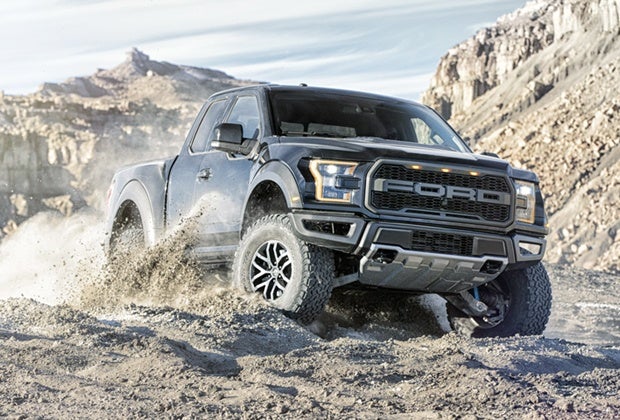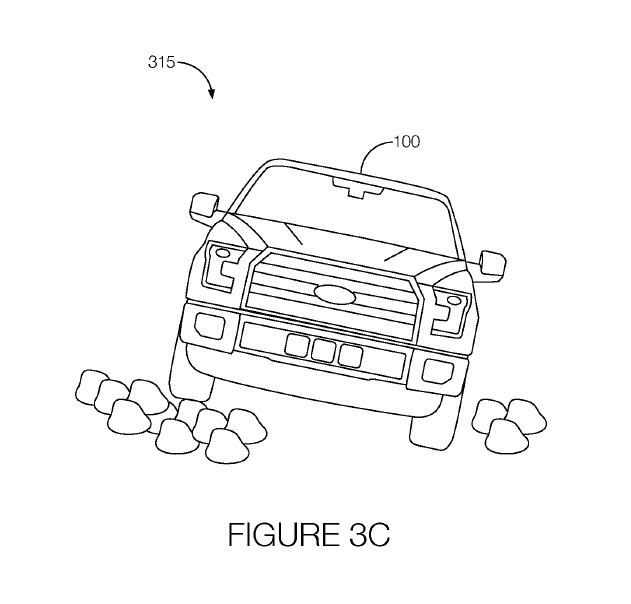The engineers at Dearborn are working on a new system that will let drivers wheel over gnarly rocks and hoover down two burritos at the same time.
Realizing the phrase ‘autonomous’ itself is a challenge to define correctly, Ford has been granted a patent for technology which allows a truck to traverse a stretch of terrain all on its own. Whether this is truly ‘autonomous driving’ is up for debate, one which we will leave to the experts in that field.
Whatever one calls it, this application incorporates a computer processor with access to instructions stored in memory which will allow the vehicle to evaluate a certain environment and, if it deems the situation to be safe, traverse an obstacle while controlling an active suspension system.
READ MORE: The Mental Hennessey VelociRaptor 6×6 Invades SEMA
In plain English, Ford’s system lets the truck do some of the heavy lifting while on the trail while the driver enjoys a snack. Okay, maybe the driver won’t be wolfing down a burger but this system does have the potential to take over driving duties during tough ‘wheeling maneuvers.
The patent document includes a flow chart which momentarily caused this author’s brain to explode but ultimately provided good insight into how the system works. When the truck’s sensor net detects an obstacle, it makes a determination if the truck can safely navigate the obstruction.
If yes, the truck’s computer will send a signal to the active suspension system, which then figures out if the truck can go over the terrain with passengers in the vehicle.
Wait, what?
Yes, dear reader. It would seem that Ford’s solution for hands-free wheeling includes, well, no hands at all. If the system deems the slovenly humans worthy of passage, the journey will proceed with either the computer or driver taking the reins to navigate the path ahead.
If the computer thinks the terrain ahead is within the truck’s capability but calculates there may be a risk of rollover, line 445 of the flow chart instructs the truck to ‘Alert Passengers to Exit Vehicle’, at which point the truck could potentially carry on without them, using sensors or cameras to make sure no one’s inside the rig while it’s moving. Alrighty, then.
READ MORE: Getting a Little Too Dirty in the Ford Raptor
Alert readers of the patent will spy the allowance for a ‘remote device’ presumably some sort of handheld controller or smartphone app to override the autonomous system if the owner thinks their expensive, self-driving Raptor is about to go bottom up.
The Blue Oval is no stranger using technology to help drivers out of tricky situations. The company’s Pro Trailer Backup Assist uses a combination of cameras, drive-by-wire steering, and a bunch of math in an effort to prevent drivers from jackknifing the family RV when backing into a camping spot.
This new system is simply a continuation of existing technology, extended to new components on the truck – in this case, an active suspension. It is the notes on this part of the system which really gets this author excited because even without the autonomous tech, an active suspension on an off-road focused machine would be a boon to enthusiasts.
A fully active suspension can adjust various dynamic characteristics for off-road driving purposes. For example, ride height, the stiffness of the suspension springs, damping rates of the shocks, even the relative position between each individual wheel and the vehicle body can be adjusted either by the driver or, you guessed it, a computer.
Off-road, this would be the holy grail. If the system detects large rocks, it would be able to put itself into some sort of rock crawling mode. The system would also be able to combine its strengths in especially tricky spots, such as if it encountered a ditch full of obstacles that collectively exceed the truck’s ground clearance. In that case, the truck could activate settings for the suspension which allow it to traverse the steep gully while simultaneously jacking everything up in order to clear the obstructions.
Some adjustments, such as hiking the ride height, could be made to the whole vehicle while others may be made to only one particular part of the truck. In addition, the system may send multiple signals at the same time to simultaneously actuate the braking, steer to the left, and raise a wheel … all on one corner.
Ford suggests in the patent that the system would ‘see’ these obstacles with either a camera, LIDAR, radar, ultrasound, map data, or some combination of all these.
Many trucks and SUVs already have some form of downhill-descent control which could be construed as a form of autonomous control, so this is not entirely new territory. What is new is the truck’s ability to make decisions for itself. That, combined with the enormous potential of an active suspension, has us looking eagerly at the future of off-roading.




 Your Privacy Choices
Your Privacy Choices